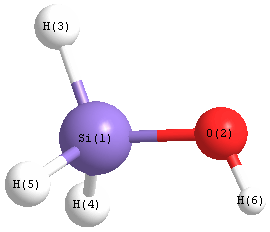Vibrational Frequencies calculated at B2PLYP/daug-cc-pVTZ
| Mode Number |
Symmetry |
Frequency
(cm-1) |
Scaled Frequency
(cm-1) |
IR Intensities
(km mol-1) |
Raman Act
(Å4/u) |
Dep P |
Dep U |
|---|
| 1 |
A' |
3896 |
3896 |
88.87 |
85.89 |
0.17 |
0.29 |
| 2 |
A' |
2292 |
2292 |
102.43 |
130.86 |
0.17 |
0.29 |
| 3 |
A' |
2247 |
2247 |
94.16 |
240.16 |
0.05 |
0.09 |
| 4 |
A' |
1004 |
1004 |
183.00 |
2.14 |
0.74 |
0.85 |
| 5 |
A' |
986 |
986 |
102.83 |
4.49 |
0.74 |
0.85 |
| 6 |
A' |
908 |
908 |
27.05 |
6.27 |
0.32 |
0.49 |
| 7 |
A' |
840 |
840 |
175.75 |
7.34 |
0.18 |
0.31 |
| 8 |
A' |
690 |
690 |
64.34 |
2.62 |
0.62 |
0.76 |
| 9 |
A" |
2242 |
2242 |
170.38 |
60.58 |
0.75 |
0.86 |
| 10 |
A" |
968 |
968 |
76.13 |
5.69 |
0.75 |
0.86 |
| 11 |
A" |
723 |
723 |
62.57 |
4.42 |
0.75 |
0.86 |
| 12 |
A" |
194 |
194 |
97.21 |
0.55 |
0.75 |
0.86 |
Unscaled Zero Point Vibrational Energy (zpe) 8495.2 cm
-1
Scaled (by 1) Zero Point Vibrational Energy (zpe) 8495.2 cm
-1
See section
III.C.1 List or set vibrational scaling factors
to change the scale factors used here.
See section
III.C.2
Calculate a vibrational scaling factor for a given set of molecules
to determine the least squares best scaling factor.
Charges, Dipole, Quadrupole and Polarizability
Charges from optimized geometry at B2PLYP/daug-cc-pVTZ
Charges (e)
| Number |
Element |
Mulliken |
CHELPG |
AIM |
ESP |
| 1 |
Si |
1.186 |
|
|
|
| 2 |
O |
-0.070 |
|
|
|
| 3 |
H |
-0.344 |
|
|
|
| 4 |
H |
-0.353 |
|
|
|
| 5 |
H |
-0.353 |
|
|
|
| 6 |
H |
-0.066 |
|
|
|
Electric dipole moments
Electric dipole components in Debye
(What's a Debye? See section
VII.A.3)
| |
x |
y |
z |
Total |
| |
-1.284 |
-0.043 |
0.000 |
1.284 |
| CHELPG |
|
|
|
|
| AIM |
|
|
|
|
| ESP |
|
|
|
|
Electric Quadrupole moment
Quadrupole components in D Å
| Primitive |
|---|
| | x | y | z |
|---|
| x |
-20.230 |
-2.921 |
0.005 |
| y |
-2.921 |
-20.837 |
0.014 |
| z |
0.005 |
0.014 |
-22.119 |
|
| Traceless |
|---|
| | x | y | z |
|---|
| x |
1.247 |
-2.921 |
0.005 |
| y |
-2.921 |
0.338 |
0.014 |
| z |
0.005 |
0.014 |
-1.585 |
|
| Polar |
|---|
| 3z2-r2 | -3.170 |
|---|
| x2-y2 | 0.606 |
|---|
| xy | -2.921 |
|---|
| xz | 0.005 |
|---|
| yz | 0.014 |
|---|
|
Polarizabilities
Components of the polarizability tensor.
Units are
Å
3 (Angstrom cubed)
Change units.
| |
x |
y |
z |
| x |
4.910 |
-0.031 |
-0.001 |
| y |
-0.031 |
5.037 |
-0.001 |
| z |
-0.001 |
-0.001 |
4.856 |
<r2> (average value of r
2) Å
2
| <r2> |
39.524 |
| (<r2>)1/2 |
6.287 |
